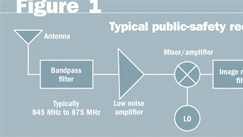The finer points of rebanding
Last month’s Tech Speak focused on techniques for measuring interference in the 800 MHz band, both during and after the rebanding process, and touched upon strategies to mitigate that interference. This month, we examine mitigation techniques in greater detail.
Before the FCC last summer ordered Nextel Communications to reband the airwaves over the next three years, many licensees questioned whether rebanding by itself actually would eliminate interference. These skeptics were correct as rebanding by itself does not eliminate interference. Instead, it creates necessary conditions so that two important mitigation techniques become effective. This article describes how Nextel can put these mitigation techniques to use after rebanding.
Let’s begin with a refresher on the types of interference created by Nextel and the A-Band cellular carrier. This interference affects the portable radio receiver (not the repeater receiver) and falls into two categories:
-
Receiver intermodulation is a non-linear combination of two or more interfering signals inside the receiver front-end (low-noise amplifier and/or mixer).
-
Out-of-band emissions (OOBE) comprise radio frequency energy that falls outside the assigned channel for the transmitter. OOBE includes radio carrier harmonics, transmitter intermodulation products, and broadband transmitter noise typical of digital radio transmitters.
A block diagram for a typical public-safety radio receiver is shown in Figure 1. Public-safety receivers are vulnerable to receiver intermodulation because the front-end bandpass filter must pass all frequencies from 851 MHz to 869 MHz. Nextel frequencies fall within this same band, so the low-noise amplifier that follows the bandpass filter is exposed to strong interfering signals that mix within the amplifier.

An intermodulation, or IM, product between two interferers with frequencies ƒ1 [lower frequency] and ƒ2 [higher frequency] can be represented mathematically, as depicted in Equation 1. Using this formula, two interferers operating at 861.4875 MHz and 862.4875 MHz will create the third-order IM products inside the 800 MHz band depicted in Equation 2.
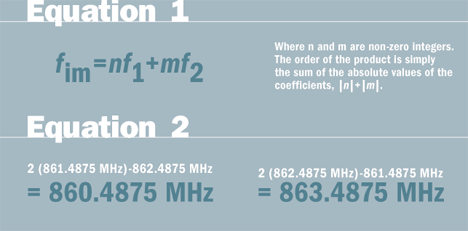
An important rule-of-thumb for two-transmitter, third-order products is that the products will fall exactly =ƒ1-ƒ2 below the lower frequency and above the higher frequency. It also should be noted that three interferers also can create third-order products, which take the form A+B-C rather than 2A-B, and that three-carrier products are more numerous than two-carrier products, as shown in Equation 3.
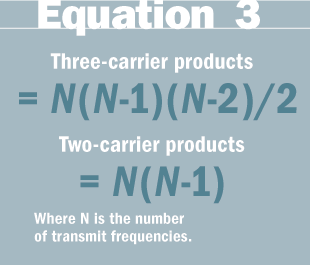
Generally — given a set of potential interfering frequencies that fall within the range [ƒmin, ƒmax] — no third-order product can fall farther than =ƒmax-ƒmin below ƒmin or above ƒmax. A sufficient condition to preclude third-order IM products is stated mathematically in Equation 4 on page 22, while this principle is shown graphically in Figure 2. Note that this article is focusing on third-order products exclusively. While fifth-order products do occur, they usually are weak enough in a Class A receiver that they can be ignored.
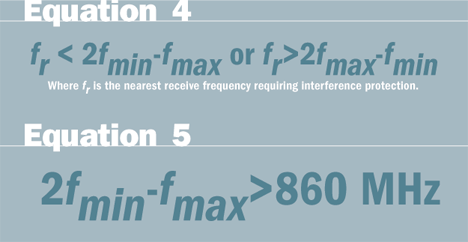
Given Figure 2, a simple way to eliminate receiver intermodulation is to first create a guard band between dissimilar services and then ensure frequency sets for the interfering service (e.g., Nextel) have a span no greater than the span of the guard band. Because guard bands waste spectrum, it is important to limit the number of band edges between the two dissimilar services so only one guard band is required. This is precisely what the FCC has done with its rebanding plan.

The 851 MHz to 869 MHz band now consists of four sub-bands as shown in the before segment of Figure 3.
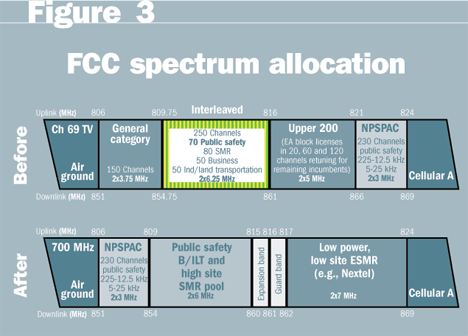
Note that public-safety channels occur in the interleaved band and in the NPSPAC band. Interleaving alone creates insurmountable problems, but the four band edges also create problems. The proposed rebanding in the after segment of Figure 3 reduces the band edges from four to one and effectively creates a 2 MHz guard band where Nextel has agreed to certain significant service restrictions.
The 2 MHz between 860 MHz and 862 MHz is subdivided into an expansion band (860 MHz to 861 MHz) and a guard band (861 MHz to 862 MHz). No public-safety system is required to remain in or relocate to the expansion band, although they may do so voluntarily. The level of protection afforded in the expansion band creates the effect of a pseudo-guard band, which has a twofold purpose: It allows bandpass filters at the cell site to roll off, and it enables Nextel to create channel plans with intermodulation products that fall in the guard band, but not on public-safety channels.
After rebanding, the solution to OOBE is straightforward. Each of Nextel’s transmit antenna sectors in potential problem areas should have a cavity bandpass filter designed to pass 862 MHz to 869 MHz and reject all frequencies below 860 MHz by at least 45 dB.
The solution to receiver IM also is straightforward. The objective is to create channel sets using all of Nextel’s rebanded channels (280 total) without creating any third-order IM products on or adjacent to a public-safety channel. For each Nextel channel set with a minimum frequency [ƒmin] the maximum frequency [ƒmax] must obey the rule depicted in Equation 5.
There are many feasible solutions to this problem. Using a seven-cell, sectored re-use pattern with 280 total channels, Nextel only requires 13 channels per sector [280/7/3]. A three-cell reuse pattern requires 31 channels per sector. For an iDEN system, three-cell re-use is likely to be a worst-case scenario.
We know that Nextel can combine adjacent channels on the same sector antenna using hybrid combiners. Thus, 13 channels require only 325 kHz and thirty-one channels require 775 kHz. But the proposed effective guard band is 2 MHz, so feasible solutions exist. A potential frequency set is listed in Table 1 on page 23.
Note from Table 1 that we have limited the range of frequencies in each cell site (three sectors total) so IM products that would occur between sectors still fall above 860 MHz. Thus, a public-safety receiver operating in the overlap region between sectors is still protected.
Channel sets A1, A2 and A3 have less than 31 channels, but these sets can be assigned to relatively low-capacity sites.
Table 1 is only one feasible solution. There are literally hundreds of practical solutions that meet Nextel’s capacity needs while fully protecting public safety from all third-order IM products. Any channel set that obeys Equation 5 within a sector and between adjacent sectors is a feasible solution. Of course, Nextel does not consult the author when preparing its frequency plan, so the company might take a different approach.
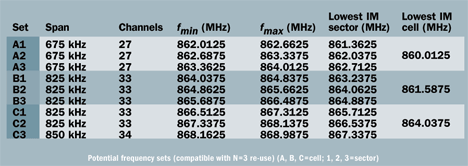
So, is interference eliminated entirely? No. There are still isolated opportunities for interference to occur, especially at Nextel/A-Band co-location sites. These require special attention and exist to keep the consulting engineer gainfully employed.
Jay Jacobsmeyer is president of Pericle Communications Co., a consulting engineering firm located in Colorado Springs, Colo. He holds bachelor’s and master’s degrees in Electrical Engineering from Virginia Tech and Cornell University, respectively, and has more than 20 years experience as a radio frequency engineer.


